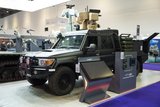Cassidian to supply IFF systems to French forces
Cassidian will supply the French Armed Forces with advanced identification systems used to prevent friendly fire, the company announced on 16 July.
The French defence procurement agency, the DGA, recently awarded Cassidian a contract to supply 150 units of its newly developed MSR 1000 I interrogator for short-range friend-or-foe identification (IFF). The first units will be delivered by mid-2014.
The systems are destined for installation on the army’s Mistral missile launchers and Martha air defence command and control stations as well as on the armoured launch vehicles of the air force’s Crotale NG missile.
According to the company, the MSR 1000 I (MSR standing for monopulse secondary radar) is a suitable product for many platforms requiring Mode 5 such as Stinger, the German LeFlaSys or the British HVM.
‘The MSR 1000 I will be able to quickly and safely identify aircraft by using highly sophisticated encryption techniques to avoid hostile signal manipulation, thus overcoming the limits of the present IFF systems and facilitating commanders’ decisions whether to engage aircraft or not,’ the company said in a statement.
‘At the same time, a new civil mode S can thus be used by both civil and military authorities. Mode S actually helps to manage the growing volume of civil air traffic, improving the efficiency of flight control by addressing aircraft with their unique identity code.’
Meanwhile, Cassidian signed an agreement at the Farnborough International Airshow with EADS North America and ITT Exelis to work together to provide enhanced electronic warfare solutions, particularly in the area of aircraft survivability equipment.
In a memorandum of understanding, the three companies agreed to combine their respective capabilities for targeted global opportunities. One of their first joint projects is expected to be a missile approach warning solution for the US Air National Guard.
More from Digital Battlespace
-
![Babcock nears first customer for Nomad AI translation tool]()
Babcock nears first customer for Nomad AI translation tool
Nomad can provide militaries with real-time intelligence, saving critical time on the battlefield.
-
![AUSA 2025: Israel’s Asio Technologies to supply hundreds of improved Taurus tactical systems]()
AUSA 2025: Israel’s Asio Technologies to supply hundreds of improved Taurus tactical systems
Taurus operates alongside the Israel Defense Forces’ Orion system which supports mission management across tens of thousands of manoeuvring forces, from squad leaders to battalion commanders.
-
![AUSA 2025: Kopin pushes micro-LED plans as China moves faster]()
AUSA 2025: Kopin pushes micro-LED plans as China moves faster
The plan for the new displays follows fresh investment in Kopin’s European facilities by Theon and an order for head-up displays in fielded aircraft, with funding from the US Department of Defense.
-
![AUSA 2025: Persistent Systems to complete its largest order by year’s end]()
AUSA 2025: Persistent Systems to complete its largest order by year’s end
Persistent Systems received its largest ever single order for its MPU5 devices and other systems earlier this month and has already delivered the 50 units to the US Army’s 4th Infantry Division.
-
![Aselsan brings in dozens of companies and systems under the Steel Dome umbrella]()
Aselsan brings in dozens of companies and systems under the Steel Dome umbrella
Turkey has joined the family of countries attempting to establish a multilayered air defence system with government approval in August 2024 for the effort landed by Aselsan. Dubbed Steel Dome, the programme joins Israel’s Iron Dome, the US Golden Dome, India’s Mission Sudarshan Chakra and South Korea’s low-altitude missile defence system.
-
![DSEI 2025: MARSS unveils new agnostic multidomain C4 system]()
DSEI 2025: MARSS unveils new agnostic multidomain C4 system
MARSS’ NiDAR system has been deployed using sensors from static platforms to provide detection and protection for static sights, such as critical infrastructure, ports and military bases.



























